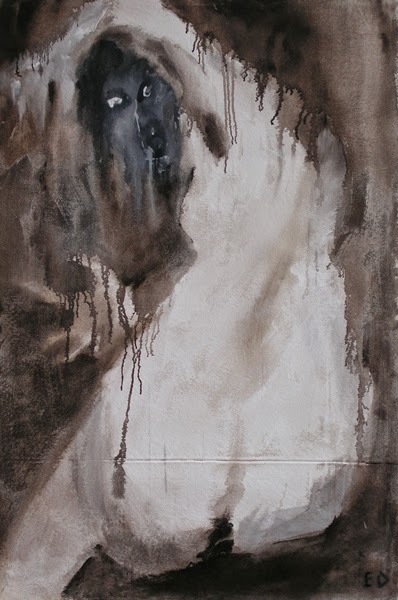ED Anna, acrylic on Mylar, 36X48, 2013
Awake and not hallucinating, image shapes itself following the rules of common
understanding.
Before she is taught, a child doesn’t see in geometrical
perspective.
The concept of discerning visual complexity into simplistic
scheme of a horizon line with two vanishing points is an invention of the Renaissance,
a developmental window in human evolution. The peculiar method of depicting 3-D
images on 2-D surfaces introduced people to imaginary trips in newly discovered previously non-existing space. For centuries to
come paintings and murals on the walls of palaces and churches and their architecture
itself emphasized linear space expansion as the only logical,
rational, and realistic way of seeing and protectively avoided anything that
might have stigmatized that picture.
It may sound strange, but like the food we eat is capable of
changing our digestion, the images we are presented with change
our vision.
The world is too complex to process in one glance; simplifications,
transformations, descriptions, maps, applied techniques and processes are needed.
Before photography folks had book illustrations to teach the
“meaning” of raw material upsetting their senses.
Seeing is not an isolated task. We rely on collectivity and
accumulated intellect of all sorts to transfer neurological stimuli into images
we can digest.
Before humanity was granted camera objectivities cultures
had different visions.
In Renaissance geometrical perspective tunneled vision
in isolated directions.
In cosmic architecture of a dome structure space evolved
around the center.
Flat characters of Turkish miniatures inhabited the flatness
of infinite world.
Reverse perspective of Byzantine mosaics installed mystical
practices and paradoxical insights in Byzantine psyche.
How Byzantine mosaic, Turkish miniature, or Renaissance painting represent the same notion of a human being?
One must blindly
believe in objectivity of camera distortions to overlook alternative realisms.
Forget the camera:
My eye, my mind, my arm, my thought, my tongue can take me anywhere from here:
1. A Portrait
What is it? Appearance? Truth?
What is a meaning of a face?
Let’s try to change the focus and watch individual features
disappear leaving us with a silhouette. I recognize it. It is you, and I, and
he, and she, and god: a human shape, an icon.
Cannon’s dead, long live the cannon!
A tribute to the antiquated notion of cannon is
its substitution, style.
What is a style but a short-lived cannon?
Style packages raw appearance, unaccounted individualities, unimagined
idiosyncrasies to take them to the market.
We march along, I with my brush, you in your make up to
pause for couple hours in The Cave, my art studio, to take a break.
We have been waiting for this encounter for our whole life.
Only two hours, and isn’t it too much to take, for you to allow
me to look through your brand and for me to allow you to witness my helplessness?
We are two toddlers here, what is your name?
2. A Dream
Where is it coming from? Is it an image or a thought? Who
thinks this thought?
What is a meaning of a dream? What worth the meaning I
assign to it?
I take a brush to paint a dream. Is there a geometrical or a
reverse perspective, a flat infinity or an interior of a sphere? Are all those
notions just a mental construction of my helpless awareness?
3. Visual Imagination
Forget about it, its getting old! Aren’t you fed up with
the mudflow of imageshit already?
I lost my meaning
I found my meaning but lost the image
I want to talk but something’s stuck in my throat
Khah-khah..
It was the image. Good thing I coughed it out or it would
have killed me from within!
It better grow outside me now
Look, it is huge! I start to walk around but it moves, and
rumbles, and rolls to the edge and falls down. It was too close! Why didn’t I
take a snapshot? Now it’s all gone forever.
I am alone and empty
My brush is dry.













